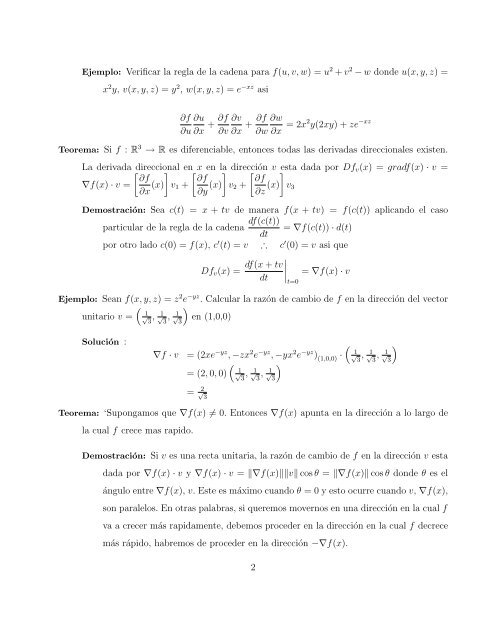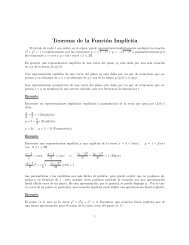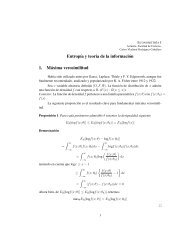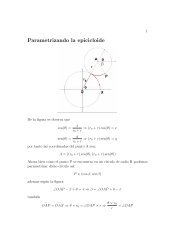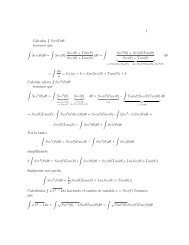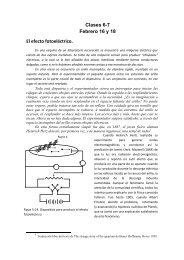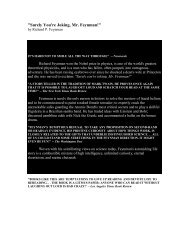Regla de la Cadena
Regla de la Cadena
Regla de la Cadena
Create successful ePaper yourself
Turn your PDF publications into a flip-book with our unique Google optimized e-Paper software.
Ejemplo: Verificar <strong>la</strong> reg<strong>la</strong> <strong>de</strong> <strong>la</strong> ca<strong>de</strong>na para f(u, v, w) = u 2 + v 2 − w don<strong>de</strong> u(x, y, z) =<br />
x 2 y, v(x, y, z) = y 2 , w(x, y, z) = e −xz asi<br />
∂f ∂u ∂f ∂v ∂f ∂w<br />
+ +<br />
∂u ∂x ∂v ∂x ∂w ∂x = 2x2y(2xy) + ze −xz<br />
Teorema: Si f : R 3 → R es diferenciable, entonces todas <strong>la</strong>s <strong>de</strong>rivadas direccionales existen.<br />
La <strong>de</strong>rivada<br />
<br />
direccional en x en <strong>la</strong> dirección v esta dada por Dfv(x) = gradf(x) · v =<br />
∂f<br />
∇f(x) · v =<br />
∂x (x)<br />
<br />
∂f<br />
v1 +<br />
∂y (x)<br />
<br />
∂f<br />
v2 +<br />
∂z (x)<br />
<br />
v3<br />
Demostración: Sea c(t) = x + tv <strong>de</strong> manera f(x + tv) = f(c(t)) aplicando el caso<br />
particu<strong>la</strong>r <strong>de</strong> <strong>la</strong> reg<strong>la</strong> <strong>de</strong> <strong>la</strong> ca<strong>de</strong>na df(c(t))<br />
= ∇f(c(t)) · d(t)<br />
dt<br />
por otro <strong>la</strong>do c(0) = f(x), c ′ (t) = v ∴ c ′ (0) = v asi que<br />
<br />
df(x + tv <br />
Dfv(x) = <br />
dt<br />
= ∇f(x) · v<br />
Ejemplo: Sean f(x, y, z) = z2e−yz . Calcu<strong>la</strong>r <strong>la</strong> razón <strong>de</strong> cambio <strong>de</strong> f en <strong>la</strong> dirección <strong>de</strong>l vector<br />
<br />
1<br />
unitario v = √3 , 1 √ ,<br />
3 1<br />
<br />
√ en (1,0,0)<br />
3<br />
Solución :<br />
t=0<br />
∇f · v = (2xe −yz , −zx 2 e −yz , −yx 2 e −yz ) (1,0,0) ·<br />
= (2, 0, 0)<br />
= 2<br />
√ 3<br />
<br />
√3 1 , 1 √ ,<br />
3 1<br />
<br />
√<br />
3<br />
<br />
√3 1 , 1 √ ,<br />
3 1<br />
<br />
√<br />
3<br />
Teorema: ‘Supongamos que ∇f(x) = 0. Entonces ∇f(x) apunta en <strong>la</strong> dirección a lo <strong>la</strong>rgo <strong>de</strong><br />
<strong>la</strong> cual f crece mas rapido.<br />
Demostración: Si v es una recta unitaria, <strong>la</strong> razón <strong>de</strong> cambio <strong>de</strong> f en <strong>la</strong> dirección v esta<br />
dada por ∇f(x) · v y ∇f(x) · v = ∇f(x)v cos θ = ∇f(x) cos θ don<strong>de</strong> θ es el<br />
ángulo entre ∇f(x), v. Este es máximo cuando θ = 0 y esto ocurre cuando v, ∇f(x),<br />
son paralelos. En otras pa<strong>la</strong>bras, si queremos movernos en una dirección en <strong>la</strong> cual f<br />
va a crecer más rapidamente, <strong>de</strong>bemos proce<strong>de</strong>r en <strong>la</strong> dirección en <strong>la</strong> cual f <strong>de</strong>crece<br />
más rápido, habremos <strong>de</strong> proce<strong>de</strong>r en <strong>la</strong> dirección −∇f(x).<br />
2


